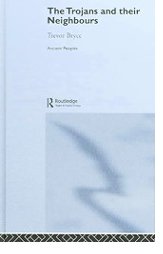
The Trojans and their Neighbours
Trevor Bryce
225 pages including index
published in 2006
The cover looks like it should belong on the course book of a not particularly interesting IT certification course, but don't let that fool you. Behind it hides one of the more engaging and interesting history books I've read in the past year or so. Which came as no surprise to me, as I had already read one of Trevor Bryce's other history books, The Kingdom of the Hittites. The cover therefore couldn't scare me off...
The subject itself helps as well of course. The story of Troy, the city at the heart of Homer's Iliad, thought to be no more than a myth until Schliemann actually dug it up remains endlessly fascinating to anybody interested in ancient history. As Bryce mentions, even today the question of whether or not the Troy Schliemann dug up was the "real" Troy, Homer's Troy is still hotly debated. But as Bryce argues, this is also the least interesting question you can ask about the actually existing Troy. Troy existed for several thousand years and was a flourishing community long before and after the Trojan War supposedly happened. With an emphasis on the Bronze Ages, The Trojans and their Neighbours attempts to put straight the real history and position of Troy -- was it as important a city state as you would assume from Homer, or just another smallish Bronze Age settlement, and what were its relations with its neighbours?
But Bryce still has to deal with the Homeric question, of how the real Troy relates to the Troy out of myth and tradition. and how and if an answer can be found; how much can ever be known about this. Bryce spends the first chapter talking about this. This chapter also functions as an introduction to the subject as a whole. Bryce is cautious in his approach here, careful to explain how much we can't say for certain about the relationship between the real and the mythical Troy, though he is more certain about the existence of Homer. He describes him as most likely to have been living in the Troad, the region around Troy, during the Greek Dark Ages, some time after the Late Bronze Age, familiar with both local and Greek tradition.
From this discussion of the Homeric tradition, Bryce moves on to the rediscovery of Troy by Schliemann, segueing into an overview of the archaeological layers of the city and an overview of its earliest history. Troy's history is that of nine different cities, each "superimposed upon its predecessor" as Bryce puts it, each city distinguishable from the others through the layering of archaeological evidence, with obvious breaks between those mayor layers and various sub-layers in most. There was then a continuous presence at Troy from at least 3,000 B.C.E. to the first millennium C.E., though the population groups of the city may very well have changed during the breaks between layers. Of the first five cities, Troy II was the richest, with Troy III being distinctly more primitive than its predecessor and Troy IV being somewhat richer but not equaling Troy II. These cities all existed during the Early to Middle Bronze Age, when most of their contemporaries were city states like Troy, though the first true empire, that of Sargon in Mesopotamia, was founded at the time of Troy III.
The city reached its peak in level VI, currently the level most associated with the Troy out of the Iliad. This is also the most controversial level, in that there's a lot of disagreement within the historian and archaeological community on how big and hence how powerful the city was. The excavated parts of the city are actually quite small, especially when measured against Homer's descriptions. The question then is whether or not this is the entire city, or whether parts of it were laying outside the city walls. Bryce is again cautious on this, laying out the evidence for both positions but taking the middle way himself.
After an archaeological description of this level as well as level VII, the next three chapters examine Troy's Aegean neighbours, its wider role and status in the Late Bronze Age and its allies, as mentioned by Homer. Again the question is how big, important and powerful Troy as a nation was. Was it an independent city state, a mini empire, or was it a vassal of the one known Anatolian superpower of that time, the Hittites? As expected from Bryce, he has a lot to say about the latter, making a good argument for the idea that at the very least Troy was one of the Hittites' allies, if not a vassal state. In doing so he also touches upon the difficult question of how to interpret the archaeological evidence. You can tell a lot from it, how a city looked or what daily might have looked like, but you can't get a sense of what language its people spoke or what they called the city itself, let alone the contemporary geopolitical realities. For that you need textual evidence, in as far that is available, and then you have to reconcile that evidence with the archaeological record, to e.g. match names to excavated cities.
The "post-Iliad" layers of Troy are again dealt with in one chapter and basically tell a story of slow, steady decay, with Troy ending its long history as just a small Byzantine city. In the final chapter Bryce returns to the question of whether or not the physical city is the Troy of Homeric legend, with the short and the long of it being that we really can't tell.
Though at times Bryce's writing is a bit dry, on the whole this was a densely packed, very interesting look at a great subject, one of those books that makes you smarter for reading it.